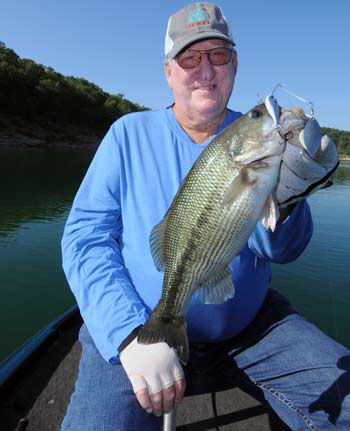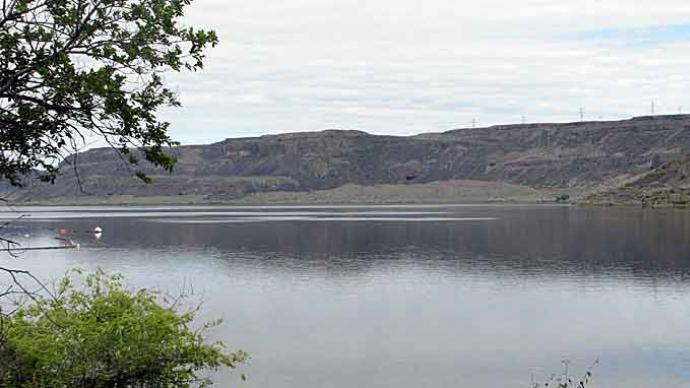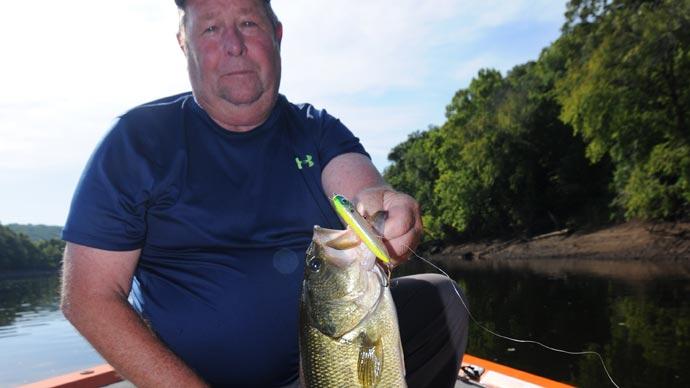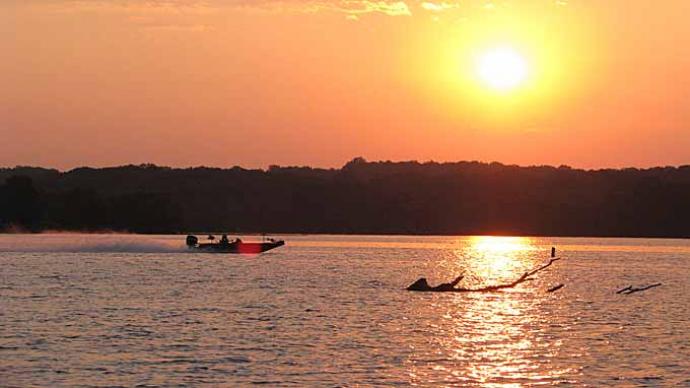
The ideal summer residence for bass requires the right combination of water temperature and oxygen.
The right combination of water temperature and oxygen in large lakes and reservoirs can be found in the thermocline, the transition layer between warmer mixed water at the surface and cooler deep water below. "The thermocline is important to bass because not only do bass hold at that depth, but the shad will hold right above it too," says Lyndall Helms, a former lure designer for Bandit Lures and current lure designer for Jewel Bait Company.
The Arkansas angler targets largemouth, smallmouth, and spotted bass hanging around the thermocline on his home waters of Bull Shoals Lake. "The bass like certain temperatures, and they will get down to the thermocline, which on Bull Shoals is about 25 to 30 feet," he says, "That is the comfort zone of bass, and they bite pretty well there." Helms notes that the surface water temperature will be in the 80-degree range during the summer and gradually drops to 66 to 68 degrees at 25 to 30 feet deep at Bull Shoals.
The lure designer notices the thermocline starts to set up on Bull Shoals in the summer at about 8 to 10 feet deep when the surface temperature climbs to about 75 degrees. As the water temperature climbs, the thermocline descends and settles into the 25- to 30-foot range by July and mid-August. The thermocline drops to 35 to 40 feet deep by late August, eventually dissipating around October when the surface water temperature falls to around 70 degrees.
"Usually (the thermocline) starts setting up good in highland lakes like Bull Shoals and Table Rock in June," Helms says. "Once that happens, a lot of fish get on it. You'll notice you will catch a lot of bass along the bank early, but as soon as that bite is over, you wonder where the fish are. It's like they quit, or you will just catch little ones. The bass have backed out then and are hanging right over that thermocline where it is comfortable."
Your electronics will help you find the depth of the thermocline, which sometimes appears as a steady line across the graph's screen. "Usually, the thermocline (on the graph) has a hazy look to it," Helms says. "You can turn up your gain or sensitivity and pick it up better sometimes. You just have to have an open mind when looking at your graphs. If you keep seeing everything setting up at 30 feet, that is probably where the thermocline is."
Finding the proper structure with a significant presence of baitfish on it is also a key to catching thermocline bass. Helms locates the largest concentrations of thermocline bass in deep water around outside channel bends of creeks and tributaries, drop-offs, points, and tops of standing timber that extend up to the thermocline.

Helms tempts the fish with a couple of baits when he finds several bass hanging around the thermocline. He usually starts with a Jewel Bait Company Live Spin, a 2.5-inch, 1-ounce lure he designed that projects well on forward-facing sonar. Helms will switch to vertical jigging a drop shot rig if the thermocline bass are finicky. "It is a matter of keeping something on that thermocline once you figure out what depth the bass are on it," Helms says.
The heavy Live Spin can be cast a long distance and falls quickly to the thermocline. The lure's custom "spiral blade" triggers strikes as it drops horizontally or vertically to the thermocline. The Live Spin's design allows anglers to keep the lure at the depth of the thermocline for as long as it takes to trigger a strike.
Helms doesn't use forward-facing sonar, so after casting the Live Spin, he counts it down, estimating that the heavy lure falls 2 feet per count. When he counts to 20, Helms knows the lure is about 40 feet. Strikes usually occur for him on the Live Spin’s initial fall or when he holds the lure at the thermocline and employs a series of raising and dropping the bait.
Helms will switch to a drop shot rig featuring a 5/16-ounce weight and a 3-inch Tater Baits Tater Shad or a Z-Man 3.75 StreakZ minnow imitator if these tactics fail to produce or if the bass keep short striking. Helms presents his drop shot bait to thermocline bass by letting it sit completely still, or he wiggles it “just a little bit.”
Helms’ thermocline tactics produce both numbers and quality bass throughout the summer. "I have caught as many as 60 to 70 bass many days on Bull Shoals on the Live Spin, and I will catch everything: walleyes, stripers, white bass all setting up on that thermocline," he says. Helms claims he has caught several 6-pound largemouth and 3- to 4-pound smallmouth on his thermocline presentations.
You can get additional tips like these from the author’s book, “101 Bass Fishing Tips, Twenty-First Century Bassing Tactics and Techniques from All the Top Pros.” Order an autographed copy by visiting https://jnoutdoors1.jnoutdoors.com.




